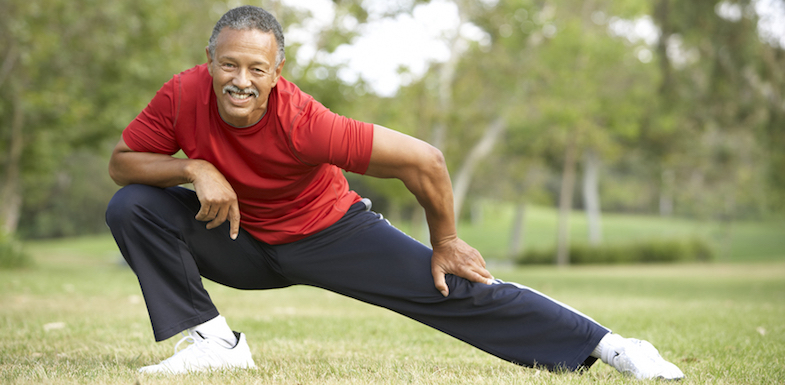
As people age, the natural flexibility and fluidity of the youthful body begins to fade. However, if you make the effort to maintain that sense of flexibility, you can often reap the benefits of better joint health for years down the line. Taking as few as five minutes per day to do stretches for hip pain can improve your joint health and enhance flexibility. In this post, we’ll cover some of the greatest benefits of hip stretches, how you can get started with them safely, and then share 29 of our favorite stretches at the end.
The benefits of doing stretches for hip pain
Nobody is immune to muscle and joint tightness: especially in the hips, and especially as people get older. Even athletes in excellent physical shape often lack flexibility, which can increase the risk for injury. Taking time to stretch can also improve your performance by increasing your range of motion and reducing recovery time, according to Summit Daily news.
For non-athletes and older people, maintaining flexibility is an important part of overall health. Many people mistakenly believe that age automatically brings with it joint and hip pain, but that doesn’t have to be the case. Focusing on a mix of strength and flexibility exercises encourages a healthy skeleton that enjoys a full range of motion while supported by strong muscles. Personal trainer Kirsten Stuart tells the Summit Daily that for many of her older clients, the biggest issue they face is staying pain free. She says:
“As we continue to get older, we start to ignore the aches and pains and push through that. Those aches and pains get a little bit more twingey and a little bit more painful…Then the twinges and aches and pains become injuries. The more proactive we are in our lives to create a smoother transition into aging, the more we’re all going to benefit.”
Ideally, a person maintains a life-long program of stretching to stop problems before they start. However, it’s never too late to increase flexibility. No matter how inflexible you are to start, there’s always a chance to improve and reap the benefits of reduced pain and greater mobility.
The following video gives a greater overview of how hip pain occurs, and how stretches can help prevent or manage some of the causes of this condition.
How does flexibility promote hip health?
When we think of flexibility, we often think of touching the toes or maybe the ability to do deep back bends. But flexibility is defined as “the ability of a joint or series of joints to move through an unrestricted, pain free range of motion,” according to the University of California, Davis.
When viewed this way, flexibility is integral to our hip’s health because pain free movement equals healthy joints. Keep in mind that balancing flexibility and strength is important. A joint that’s too flexible is more susceptible to injury, especially if the surrounding muscles are weak, offering little protection.
For older people who may be working to reverse muscle weakness and joint stiffness, starting a fitness program that targets both flexibility and strength will help them achieve more pain-free movement. For instance, strong and flexible hamstrings help to stabilize the knee joint and protect it from injury. On the other hand, tight muscles can result in pain elsewhere in the body. Tight calf muscles sometimes lead to tendinitis in the knee, according to UC Davis. Tightness in the pelvis, especially from sitting all day, can lead to hip pain.
Stretching encourages the health of joint cartilage, which is at risk of degrading as people age, resulting in arthritis, according to UC Davis. Even for those who already have arthritis, stretching may help to stave off further joint damage. Stretching helps to increase the blood flow to the joints, bringing necessary nutrients and synovial fluid, which helps joints move smoothly. Brent Sands, a sports and strength training specialist, tells the Summit Daily that stretching helps to reduce soreness from exercising, allowing people to return to the gym faster regardless of age.
How do I start a stretching routine safely?
When beginning stretches for hip pain, make sure to start slow. It’s easy to overstretch, which can result in injury and require a prolonged period of resting that sets you back from achieving flexibility goals. However, try to stretch daily, or at least as often as possible. Continued stretching is necessary to see a benefit. If you stop, you could lose the gains you made. But even if you stop, it’s never too late to start again.
Make sure to only go into the following stretches for hip pain as far as feels comfortable for you. You should feel a stretch and possibly discomfort, but never any sharp pain, especially in a joint. At the beginning, you may feel a deep stretch with only slight body movements. That’s fine. Over time, with continued practice, your flexibility will deepen. Let repetition be your effort, and let gravity do the work.
Maintain each stretch for anywhere from 30 seconds up to two minutes. Longer holds are ideal to maximize the effects, especially with large joints like the hip that require time to open up. Spend equal amounts of time on both sides of the body, or possibly a little longer on the side that feels stiffer. It’s also natural for one side of the body to feel tighter than the other. Try to avoid forcing the stiff side into a deeper stretch, instead approaching stiffness with patience.
Try to maintain long, even breaths throughout the stretch. This will help you identify if you’ve gone too far, and also help the body relax, signaling to the muscles and joints that it’s okay to release. Come out of the stretch slowly, especially if you’ve held it for a long period of time.
Add in a warm-up
Incorporating some warm-ups or stretching after exercise can be incredibly helpful as well. It’s always best to stretch a warm body, so consider starting off with even five minutes of cardio.
Consider beginning by walking for five minutes around the block. This can help you get warmed up before you start stretching. Walking is generally safe, but see how you feel the next day. Sometimes it takes time for any pain or soreness to set in.Then, consider stretching for 15 to 20 minutes after working out, recommends Sands, the strength training specialist. It’s fine to complete the same stretches every day.
Gaining fitness while staying safe requires finding your edge, that place that’s slightly beyond your comfort zone but not so far it causes injury. Ultimately, it’s better to move too slow than go too fast and injure yourself. Just do what you can. That rule applies for everyone, but especially for seniors, people with chronic pain, or those who haven’t exercised in a while.

Get professional help
Consider visiting a personal trainer or physical therapist who can help you design the right stretches for hip pain to target your personal areas of stiffness. A professional can also help you avoid any movements that are contraindicated for health issues you may have. For example, if you have back pain, it’s generally a good idea to avoid rounding the back. This means you should stretch the hamstrings while lying on the back as opposed to folding forward, which can put pressure on the lumbar spine.
For optimal results, counteract stretching with strengthening moves to make sure the muscles surrounding important joints don’t become overstretched, increasing the risk of injury.
29 stretches for hip pain
Try out the following stretches for hip pain to see which ones help you reduce your pain and discomfort. If you suffer from moderate to severe chronic pain, always talk to your doctor before attempting any new stretches or exercise regimens.
Dig into 9 hip openers
Maybe you’ve been to a yoga class in which, at some point, the instructor declared a certain position to be a “hip opener.” Or perhaps your physical therapist recommended “hip-opening” stretches or exercises — maybe he or she even showed you a few to perform at home on your own. But what does “hip opener” really mean?
Remember, that the hip joint is a ball-and-socket type of joint. The “ball” in that equation is the head of the femur, aka the thigh bone. The “socket” is the socket of the pelvis. Multiple muscles attach themselves to the femur in the area of the hip joint, and these are the muscles that benefit from hip opening exercises. Some muscles run between the femur and the pelvis, the femur and the lumbar spine, the femur and the sacrum, and so on. When you perform a hip opener, you’re stretching these muscles, in other words, elongating their muscle fibers and increasing their flexibility.
The overall goal of hip openers is to improve mobility and increase flexibility. When we practice hip openers, we’re also lubricating that hip joint, which keeps it healthy. If you’re a runner, cycling enthusiast, dancer, or sit at a desk all day long, you know how tight your hips can get if you don’t periodically stretch them out. Here’s our favorite hip opening stretches that even beginner’s can use.
Try out these 17 yoga poses for hip pain
These poses from Prevention.com and BeachBody.com range from the ultimate beginner’s poses to more advanced postures you’ll want to work up towards (we’re looking at you frog pose!). Follow the guidelines for any stretches for hip pain while you attempt these: go slow, back off if you feel any sharp pains, and practice modifications with blocks or towels if you need the help.
You’ll work through the following poses and more by clicking the links above:
- Happy baby pose
- Pigeon pose
- Thread-the-needle
- Lunges
- Hero pose
- Goddess pose

Work on hip and lower back pain with these 3 stretches
Finally, one of our favorite set of stretches for hip pain comes from Kai Wheeler, a personal trainer. This video gives a great overview of stretches you can do to relieve pain in the hips, lower back, and buttocks. It focuses on releasing pain in the piriformis.
Remember, always start slowly when working into these stretches for hip pain. With consistent work, a slow build-up to higher intensities, and a focus on how your body is feeling you can start a regimen of stretches for hip pain that is safe and effective. It can help you reduce pain in your hips and increase your overall flexibility, strength, and stamina.
If you suffer from hip pain that doesn’t respond or get better from trying these stretches, it might be time to talk to a certified pain specialist who can help you identify the source of your pain and suggest treatment options that could work for you. To get started, call a pain doctor in your area to talk about the options you have, or read more about how interventional pain management works here.’